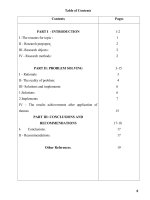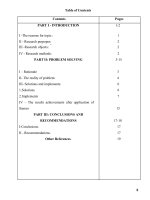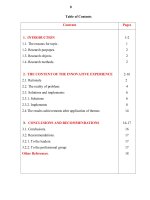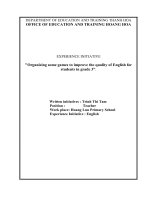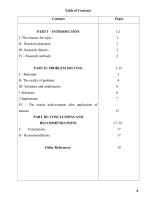Some suggestions to improve the process of employees performance appraisal in lien thanh seafood processing joint stock company
Bạn đang xem bản rút gọn của tài liệu. Xem và tải ngay bản đầy đủ của tài liệu tại đây (34.35 MB, 77 trang )
•.1
HO CHI MINH CITY UNIVERSITY OF FOREIGN LANGUAGES
AND INFORMATION TECHNOLOGY
DEPARTMENT OF FOREIGN LANGUAGES
GRADUATION PAPER
SOME SUGGESSTIONS TO IMPROVE
THE PROCESS OF EMPLOYEES'
PERFORMANCE APPRAISAL IN LIEN
THANH SEAFOOD PROCESSING JOINT
STOCK COMPANY
~
TV DQi HQc Huflit
?
A.
Student: NGUYEN THl BAO HAN
Student's Number: 0171288
Class: HAOI0l
Advisor: NGUYEN NGOC HuAN, M.B.A.
IIII111111111111111111111111
101000459
HO CHI MINH CITY, JULY 2005
HO CHI MINH CITY UNIVERSITY OF FOREIGN LANGUAGES
AND INFORMATION TECHNOLOGY
DEPARTMENT OF FOREIGN LANGUAGES
GRADUATION PAPER
SOME SUGGESSTIONS TO IMPROVE
THE PROCESS OF EMPLOYEES'
PERFORMANCE APPRAISAL IN LIEN
THANH SEAFOOD PROCESSING JOINT
STOCK COMPANY
X
NGOAI
o~
,<.,-<"
~
o
*
?"
Student: NGUYEN THl BAO HAN
Student's Number: 0171288
Class: HAOI0l
Nc }lvisor: NGUYEN NGOC HuAN, M.B.A.
THU ViEN
.
II/v".
'S-
r:
HUFLIT r
*,
{p. Ho rHl ~~
HO CHI MINH CITY, JULY 2005
ADVISOR'S COMMENTS
.0
••••••••••••••••••••••••••
0
•••••••••••••••••••••••••••••••••••••••••••••••••••••••••••••
,
......
•
•••••••••••
••••••••••
.
••••••
0
•••••••••
••••••••••••••••••••••••••••••••
0
••
0
•••••••••••••••••
0
••••••••••••••••••
0
•
0'
•••••••••••••••
•••••
••••••••
•••••••••••••
,
0
••
00
•••••••••••••••••••••••••
,
••••••••••••••••••••••••••••••••••••
•••••••••••••••
••
0
0
•
0
•••••••••
0
•••••••••••••
••
••
0
0
'0'
••
••••••••••••
0
•••••••••
0•0
••••••••••••••••••••••••••••••••••••••••••
'0'
•••••••••••••
0
0
•••••
•••••
0
0
•••••••••••••••••
••••••••••••••••••••••
..........
.
...
.
....
.
......
.
....
.
..
.
.......
.
.......................
.
..........
.
......
....
.
.
EXAMINER'S
•••••
0
•••
•
0
••••
0
•••••
••••••••••••••
•••
••••••••••••••
0
.0'
•••••••••
••••
'0'
••••••••••••••••••
••••••••
••••
0
•
•
••
0'
•••••••••
•••
0
•••••••••••••••••••••••••
••••••••••••••••••••••••••••••••••••
••••••••••••••••••••••
0
0
0
.0
0
•••••
••••••••••••••••••••••••
0
0
0
COMMENTS
•••••••••
0
•••••••••
0
0
'0'
0
••••••••
•••••
0
•••••••••••••
0
••••••••••••••••••
0
•••
••••••••
••••••
••
0
0
••••••••••••••••
•••••••••••••••••
'0'
,
••••••
•••••••••
0
•••••••••••••••••••••••••••••••••••••••••••••••••
••••••••••••••••••••••••••••••••••••••••••••••••••••••••••••
0
0
0
••••
•••••••••••••••••••••••••
0
.0
•••••••••••••••••••••••••••
•••••••••••
0
0
0
•
•••••••••
••••••••••••••••••••••
......
.
....
.,
.
.
.
....
.
............
.
.
.
........
.
.
.
.. ..
,
.
...
.
...
.
....
.
fiCKtiOWLEDGEMEtiT
cg~ro
First of all, I would like to express my deep gratitude to Mr. Huynh The Cuoc,
the principal of HUFLIT and Mr. Tran Kiet Hung - Dean of Foreign Languages
Department, for their irreplaceable encouragement and support.
I would also like to thank Ms. Bui Thi Thanh Truc and Mr. Vu Quoc Anh - Vice
Dean of Foreign Languages Department for their enthusiastic concerns and helps
during the writing of my graduation paper.
In particular, I must express special thanks to Mr. Nguyen Ngoc Huan, my
advisor, who has offered invaluable instructions, discussions, commentaries, and great
incentives. He was always available to ensure that my deadlines were met. Without his
help, this paper would not be completed.
I am indebted to Ms. Ho Thi Hoa, administrative manager of Lien Thanh Seafood
Processing Joint Stock Company for her kindness in supporting necessary information
and documents. An additional special thanks to Ms. Dang Thi Xu an, vice director of
Hung Thinh Fish Sauce Company, LTD who always makes advantageous conditions
for me to understand about her company's performance appraisal activities.
I extremely appreciate the help of my friends in sharing ideas, expressing interest,
proposing suggestions, and revising the text. Especially, I am grateful to Tran Trung
Nghia for his wonderful contribution in checking the paper's coherence.
Finally, I would like to express my deepest appreciation to my family for their
incentive, immeasurable
help and conscientiously
attention throughout this entire
process. My family is the greatest source of encouragement that always assists me in
doing any things - for which I am truly grateful.
CONTENTS
Page
INTR 0 DUCTI 0 N --------------------------------------------------------------___________________________
I
Chapter I: An overview of Human Resource Management
1.1 Understanding Human Resource Management ----------------------------------1.2 Importance of Human Resource Management -----------------------------------1.3 Performance appraisal -----------------------------------------------------
3
6
8
Chapter II: Performance appraisal in details
2.1
2.2
2.3
2.4
2.5
2.6
Uses of performance appraisal----------------------------------------------13
Responsibility for appraisal-----------------------------------------------------18
Perform an ce apprai sal methods -----------------------------------------------; 20
Characteristics of an effective performance appraisal system ------------------------------------23
Problems in performance appraisal -----------------------------------------------------24
Performance appraisal and Equal Employment Opportunity (EEO) ----------------------------26
Chapter III: Introduction to Lien Thanh Seafood Processing Joint Stock Company
3.1 An overview of Lien Thanh Seafood Processing Joint Stock
Com pany ----------------------------------------------------------------------3.2 Managerial Organization of Lien Thanh Seafood Processing Joint
Stock Com pan y --------------------------------------------------------------3.3 Human Resource Department of Lien Thanh Seafood Processing
J 0 int Stock Com pan y -------------------------------------------------------3.4 Administrative Department of Lien Thanh Seafood Processing Joint
Stock Company ------------------------------------------------------------------3.5 Organizational Chart ---------------------------------------------------------
28
3I
32
33
35
Chapter IV: Some suggestions to improve the process of employees' performance
appraisal in Lien Thanh Seafood Processing Joint Stock Company
4.1 Current performance appraisal of Lien Thanh Seafood Processing Joint
Stock Com pany --------------------------------------------------------------36
4.2 Strengths and Weaknesses of the current performance appraisal
process in Lien Thanh Seafood Processing Joint Stock Company----------------------------- __41
4.3 Preliminary assessments of the current performance appraisal process
in Hung Thinh Fish Sauce, Company, Ltd----------------------------51
4.4 Some suggestions to improve the process of employees' performance appraisal /
inLien Thanh Seafood Processing Joint Stock Company--------------------------------55
CONCLUSION ------------------------------------------------------------------------------------59
REFERENCES
APPENDIXES
ABSTRACT
***
In the recent years, the dramatically increase in merchandising activities have led to
establishment of lots of companies. To effectively operating and gaining profits, the
company's
human resource management
should not be wasted but be used in
appropriate ways. Consequently, organizations must concentrate on how to maintain a
staff of loyal employees that is willing to devote talents for their company's long time
survival. Appraisal of employee performance is thus a vital part of an organization's
strategic planning
importance,
and a means of achieving
corporate
many small and medium companies
objectives.
in Vietnam
Despite its
do not have any
systematic methods of evaluating performance. This study investigates the current
process of employees' performance appraisals in Lien Thanh Seafood Processing Joint
Stock Company and gives out some suggestions to improve the process. These
suggestions are concluded from conducting preliminary assessments of performance
evaluation in Hung Thinh Fish Sauce Company, LTD. Data for the study were mainly
collected from Lien Thanh Company by observing, interviewing, and searching related
documents.
The
analysis
showed
that
although
there
are some weaknesses,
performance appraisal in Lien Thanh Company has been considered as appropriate and
non-discriminatory
process because it achieves employees' satisfaction. However, to
become more effective, the company should take some corrective actions such as
changing the responsibility
for appraisal, establishing specific appraisal methods,
carrying out the evaluation basing on specific documents as well as on the rater's
experience, skill and knowledge of each employee's work competence, restoring data
of employees' job achievements and offering more flexible bonuses. Therefore, if Lien
Thanh Seafood Processing Joint Stock Company follows these suggestions, it would
certainly gain success in nowadays competitive and changing market place.
INTRODUCTION
G1~JjG)
Commercial market is often considered as a fighting, if a company fails to keep
pace with the pressure of global competition and social changes, it will be quickly
crossed out from the market place. Because of an organization has to face those
challenged futures, it becomes clear that whether the company's size and type, their
ability to add value to products and services will depend increasingly
on the
knowledge, skill and initiative of their employees staff. This places the performance
appraisal process
of the human resource management
department
an important
position in contributing to future corporate and national economic success.
Performance
appraisal is a process of periodic reviewing performance and
evaluating the actual working competence, the strengths and weaknesses of each
employee to find out their most suitable solutions in doing any job.
Stone (1995: 181) also emphasized the importance of performance appraisal; he
affirmed that: "Performance appraisal is a measure of organizational effectiveness. It is
through the effort of individual employee that organization objectives are met."
If employee's performance is improved, the organization in tum will earn many
benefits. Consequently, the right and appropriate performance appraisal processes will
become decisive factors in encouraging employees to work harder and feel satisfied
with their job. Despite its importance, many companies in Vietnam do not have any
systematic methods of evaluation according to recently observations.
This study aims at analyzing the process of performance appraisal to improve
the enterprises'
Human Resource Management.
Nevertheless,
being limited as a
graduation paper, it only focuses on the process of performance appraisal in Lien
Thanh Seafood Processing Joint Stock Company and gives out some suggestions for
more effective management.
PAGE
1
This graduation paper is organized into four chapters. Chapter one is an
overview of Human Resource Management. Details about the performance appraisal
are presented in chapter two. Chapter three is connected by the introduction to Lien
Thanh Seafood Processing Joint-Stock Company. Finally, chapter four ends with the
analysis of the current process of employees' performance appraisal in Lien Thanh
Company and gives out some suggestions to improve the process. These suggestions
are concluded by conducting preliminary assessments about employees' performance
evaluation of Hung Thinh Fish Sauce Company, LTD at present.
PAGE
2
C"APTER OJiE
AN OVERVIEW OF HUMAN
RESOURCE MANAGEMENT
m~
m~
m~
Understanding Human Resource Management.
Importance of Human Resource Management.
Performance appraisal.
I. AN OVERVIEW
OF RUMAN RESOURCE
MANAGEMENT
1.1 UNDERSTANDING HUMAN RESOURCE MANAGEMENT
Anyone wants to set up his or her own business must seek for a skillful employee staff
that willing to work industriously
for getting the company's
Therefore, how to manage this employees'
maximum profit.
staff effectively is one of the most
important functions of Human Resource Management Department.
Human Resource
Management
is a lengthy process
of tactful managing
and
controlling people in a good relationship between employers and employees. The term
"Human Resource Management",
thus, has become no strange to any companies
regardless of its type and size in recent years.
One of the main tasks of Human Resource Management is that human resource needs
must be taken into account in getting everyone to meet organizational objectives. Up
to now, there are numerous definitions about human resource management.
According to Harris (2000: 4), "Human Resource Management may be defined as
programs, policies, and practices for managing an organization's workforce".
Or another
definition
about Human Resource
Management:
"Human Resource
Management is the recognition of the importance of an organization's workforce as
vital human resources contributing to the goals of the organization, and the utilization
of several functions and activities to ensure that they are used effectively and fairly for
the benefit of the individual, the organization, and society." (Schuler et aI, 1996)
Alternatively,
Stone (1995: 4) also had his explanation
about Human Resource
Management; he implied that "The focus of Human Resource Management is on
managing people within the employer - employee relationship. Specifically, it involves
the productive utilization of people in achieving the organization's objectives and the
satisfaction of individual employee needs".
Because
Human
Resource
Management
seeks to integrate
the interests of an
organization and its employees, some main Human Resource Management activities
PAGE
--------~
3
of benefits have the purpose of improving the quality of work life and attracting
employees for a safe and reliable place to work in.
•
Industrial relation: is the relationship between an organization and its employees. If
the relation is good, it will enhance the spirit of collectivity between employees, while
if it is bad, there will be a conflict when employees feel that they have worked in a low
commitment environment.
•
Health and safety: to protect the employee's rights, organizations are required to
provide a safe working environment. Employees had the rights of enjoying a free
physical hazards and unhealthy conditions. Through effective and safety health
programs, the physical and mental of employees are guaranteed. (Stone: 1995: 15)
1.2 IMPORTANCE OF HUMAN RESOURCE MANAGEMENT
Human Resource Management has the task of managing people within the employeremployee relationship. Particularly, it involves activities of tactful utilizing people for
achieving the organization's
objectives and the satisfaction of individual employee
needs. Human Resource Management can also be a major contributor to the success of
the enterprise because it relates to the coordination
resource.
Stone (1995: 4) also pointed
of an organization's
out that: "ineffective
management can be a major barrier to employees'
human
human resource
satisfaction and organization's
success". For these reasons, the objectives of Human Resource Management should
take into proper consideration.
•
To attract potentially qualified job applicants
Regardless of a company's size and type, the more qualified workers you hired, the
more successful your company will get. Qualified workers are people who possess
experience for doing the job well, they are strong work force who willing to work hard
and devote their abilities for the company's overall objectives. Therefore, attracting
potentially qualified job applicants are determinants in boosting up the enterprise's
development in today competitive market place.
PAGE
6
•
To retain desirable employees
Another important objective of Human Resource Management is to retain desirable
employees. Desirable employees are workers who want to work for a long time, who
are willing to devote their talents for the company's long time survival. Because of
this, human resource managers must know how to persuade them staying long to serve
for the company. In other words, a successful company is always a place to welcome
desirable
workers,
make
advantageous
conditions
for them
to enhance
their
professional skills as well as getting promotion for them to higher positions.
•
To motivate employees
"Motivation refers to forces within an individual that account for the level, direction,
and persistence of effort expended at work." (Schermerhorn,
Hunt, and Obsorn,
1997:87)
Motivate is an essential thing in doing any job no matter what it is large or small.
Particularly in the working place, after a long time performing the same businesses,
after sometimes feel bored with the repetitive tasks. employees need a motivation.
Hence, motivations and encouragements from managers play an indispensable role in
helping employees to reduce stress and increase interest to complete their job well.
Human resource managers can apply some motivation forms such as encouraging
them to work harder, giving them a bonus or transferring them to a higher position if
their performance
is frequently
good...
All these motivations
aim at making
employees feel like their job and try hard to fulfill the job with the highest level of
satisfaction.
In general, "all human resource objectives and activities must be evaluated in terms of
how each contributes to the achievement of organization objectives." (Stone, 1995: 12).
This means that they must:
Be measurable
Include deadline dates for accomplishment
PAGE
7
IdentifY and involve the key stakeholders and/ or human resource customers to
ensure the necessary collaboration.
Nominate the individual or parties responsible for implementation.
According to Shermerhorn (1996:250), the major elements in the Human Resource
Management Process are:
- Attracting a quality workforce: managing human resource planning, recruitment, and
selection.
- Developing a quality workforce: managing employee orientation, training and
development, and career planning and development.
- Maintaining a quality workforce: managing retention and turnover, performance
appraisal, compensation and benefits, and labor- management relations.
1.3 PERFORMANCE APPRAISAL
Another key human resource management function is performance appraisal, which
helps both the manager and subordinates maintain the organization - job - employee
characteristics match.
"Performance appraisal is a process of systematically evaluation performance and
providing feedback on which performance adjustments can be made." (Schermerhorn,
Hunt, and Obsorn, 1997:116)
•
The role of performance appraisal
Performance appraisal should serve two purposes:
The evaluation purpose of performance appraisal is to let people know where they
stand in connection with performance objectives and standards. Here, the appraisal
compares the past performance with the present performance to make a conclusion
about the results and determine whether the results meet the organizational objectives
or not. Similarly, the human resource managers measure the results against standards
to put forward some improvement decisions or training program. Performance is
documented for the record, establishing a basis for allocating performance rewards.
PAGE
8
Consequently, the manager acts in the judgmental role of giving a direct evaluation of
another person's performance accomplishments.
The development purpose of performance appraisal is to assist in the training and
continued personal development of people ( Schermerhorn, 1996: 257). Here, the
appraisal concentrates on future performance and analyzes the success standards of an
employee in performing his or her daily job. It is a way of finding out some
performance obstacles and difficulties that an employee meets. From this research,
managers will decide best methods for employees to overcome these obstacles and
then identify training and development
opportunities.
The manager acts in a
counseling role, focusing on a subordinate's developmental needs.
The assessment of employees' performance contributes positively to training and
development as a Human Resource Management function. (Schermerhorn, 1996: 257)
•
Benefits of appraisal
( Locher, A.H. & Teel, K.S. (1997) Performance Appraisal: A Survey of Current
Practices, Personal Journal, Vol. 56, No.5, pp. 245-257, URL:
/>
[accessed May 2005]).
The organization's quality of product can not be enhanced, the employees' working
ability cannot be better if the company does not have an appraisal system. There are
many performance appraisals' benefits that an organization has to take into proper
consideration:
In the rush and busy of daily working life, performance appraisal offer a rare chance
for a supervisor and subordinate to have "time out" for a one on one discussion of
important work issues that might not be addressed.
If the performance appraisal is conducted properly, both employees and employers can
exchange valuable and meaningful experience in doing the job.
Appraisal offers opportunities for both supervisors and subordinates to concentrate on
work activities and goals, to correct existing problems as well as to encourage better
PAGE
9
performance if needed. Therefore, the performance appraisal of the whole organization
is enhanced.
For many employees, an "official" appraisal interview may be the only time they get
to have exclusive, uninterrupted access to their supervisor.
Motivation and satisfaction:
Performance appraisal can have a profound effect on employees' working ability as
well as their motivation and satisfaction in fulfilling the job. If the appraisal provides
fair and proper results on one employee's working performance, it can be a positive
influence
on the
individual's
sense
of worth,
commitment
and belonging.
Consequently, they will try to work better and feel satisfied about their job. On the
contrary, if the appraisal provides inexactly or bad results, it would be negative factors
that make employees feel bored and dissatisfied with their job. Thus, absenteeism and
turnover rates in the organization might be greatly increased. Regular performance
appraisal thus is a good way in providing exactly results on one employee working
performance.
Training and development:
Results from the performance appraisal indicate the current working capacity of
employees. It gives human resource managers an overview about the organizational
future career aspirations and present performance outcomes. From these results,
human research managers will decide a regular and efficient training need audited for
the entire organization.
Recruitment and Induction:
Appraisal data can be used to monitor the success of the organization's recruitment
and induction practices. Appraisal data can also be used to monitor the effectiveness of
changes in recruitment strategies and can access whether the general quality of the
workforce is improving, staying steady, or declining.
PAGE 10
Employee evaluation:
Employee evaluation is a major objective of performance appraisal. Through appraisal
results, the actual working competence of each employee appears obviously. Human
resource managers then will apply suitably reward or improvement policies for those
who perform higher than expected results or use encourage and develop policies for
those who perform lower than expected.
•
Performance appraisal objectives
Discrimination:
In order to set up a fair performance appraisal system, managers must be able to
discriminate objectively between employees who are contributing much for the
company's
achievement and those who are not. Those that are under standard
performance should be given the opportunity and assistance to improve while higher
than expected performances should be received such rewards as: praise, pay raise,
promotion, training and development. .. this discrimination helps managers thoroughly
understanding
each employee working ability to set plans for each kind of
performance.
Generally,
"discrimination
on the basis of performance
is an
organizational necessity. It is part of the managerial role that cannot be avoided. If an
organization is to survive and grow, and retain and motivate its top performers,
effective performance appraisal is a must." (Stone, 1995: 182).
Reward:
It is obvious that good, outstanding, or excellent performances must be rewarded.
Those who have devoted their talents to the company's success are praiseworthy
employees. They deserve to receive the greatest rewards. Rewarding outstanding
performances express employees' expectation on impressive results that they have
brought to the company. If no objective measure of performance exists within the
organization, no efforts or initiatives to increase the product's quality from workers
can be made. A comprehensive performance appraisal system is thus essential for
PAGE 11
spurring better performance behaviors. Stone (1995: 182) also had his own idea about
rewarding employees: "An objective performance appraisal system links employee
contributions and rewards and ensures that organization gets maximum value for its
compensation dollar".
Development:
The third aim of the performance appraisal is that of employee development. After
rewarding
employees
who constantly
create high performance
outcomes,
the
managers' job is to improve their professional skill by offering developmental
schemes. These programs are carried out in attempting to help employees develop
their initiatives, find out ways to strengthen their skills and create chances for them to
make progress. Therefore, performance appraisal must be a positive and dynamic
process in exploring how to help individual grow and develop. "Performance
improvement comes about by building on strengths and overcoming weaknesses."
(Stone, 1995: 183). In short, besides objectively discriminate employees with high
performances
and those with low performances
as well as rewarding
good
performances, an effective evaluation system must also has the purpose of establishing
plans for employee's improvement.
Communication:
Accurately communicating
one employee's
performance result is essential and
ongoing part of the evaluation process. From this communication, employees can
know clearly about their good and bad points to making suitable corrective actions as
well as creating efforts to better completing the assigned jobs. To effectively
communicate performance appraisal result, the manager simultaneously must also
understand what employees' strength and weakness are and how they can restrict their
deficiencies, know what kinds of training and development are needed, and ensure that
opportunities are created for any new job experience required. Hence, employee
communication is the fourth important purpose of performance appraisal.
PAGE 12
CHfiPTER TWO
PERFORMANCE APPRAISAL IN DETAILS
;::iS1Uses of performance appraisal.
f::iSI Responsibility for appraisal.
:::iSI Performance appraisal methods.
:':iSI Characteristics of an effective appraisal system.
f::iSI Problems in performance appraisal.
:::iSI Performance appraisal and Equal Employment Opportunity (EEO)
2. PERFORMANCE
APPRAISAL
IN DETAILS
"Performance appraisal is a system of periodic review and evaluation of an individual
or team's job performance."(Mondy et aI, 2001).
Alternatively, Stone (1995: 181) defined that: "Performance appraisal is a measure of
organizational effectiveness in which the organization objectives are met through the
effort of individual employees. If employee performance is improved, the organization
in tum will lift its performance. Appraisal of employee performance is thus a critical
and ongoing Human Resource Management Activity".
2.1 USES OF PERFORMANCE APPRAISAL
•
Human Resource planning: Human resource planning provides information about
the organizational objectives, about all recruitment, selection or promotion decisions.
Performance appraisal is helpful for the organization in evaluating how well or badly
the employees'
staff performs
the job
and making
a comparison
with the
organizational plans. This data must be available to describe the promotability and
potential of all employees, especially key executives.
•
Recruitment and selection: performance appraisal is used for predicting the
performance
of job applicants. Through behavioral interviews, human resource
managers can assess whether a job applicant's qualifications suitable for the job
vacancIes or not. Performance appraisal also provides benchmarks for evaluating
applicant responses after a specific time doing a new job.
•
Training and development: helpful in determining an individual's strength and
weakness, these data help managers put forward a suitable training and developing
program which permit employees to build on their good. points and minimize their
deficiencies.
PAGE 13
•
Career planning and development: essential in identifying potential employees who
perform the job well as well as analyzing an employee's strengths and weaknesses to
make plans for the organizational career issues.
•
Compensation programs: provide a basic for rational decisions regarding pay
adjustments.
•
Internal employee relation: data collected from the employees'
performance
appraisal are used for decisions in several areas of internal employee relations.
Managers can decide motivation or promotion for workers who have been performing
the job well or getting out-expected results. Decisions about demotion or layoff those
who constantly cannot fit the job standard for a long time are also established.
Managers can also decide to transfer an employee to a new position if they feel that he
or she does not fit the old job anymore.
•
Assessment of employee potential: through performance appraisal, managers can
identify employees who really skill at a specific job or those who perform well on their
job. From this data, a list of organization's potential employees is made. These
employees become a valuable human resource who will enthusiastically devote their
talents for the company's success.
PAGE 14
THE PERFORMANCE
APPRAISAL PROCESS
External Environment
Internal Environment
Identify Specific Performance
Appraisal Goals
Establish Job Expectations
(Job analysis)
Examine Work Performed
Appraisal Performance
Discuss Appraisal with
Employee
Source: Mondy, Noe, and Premeaux, 2001, Human Resource Management.
As the figure shows, the process of performance appraisal is affected by external
environment and internal environment. According to Nguyen (2004: 322), external
environment includes the company's competitors and the State's Labor Laws. Articles
108-109 in chapter 10 of Vietnam's Labor Law which is dated on July 5th, 1994 and
have effective on January 1st, 1995 stipulated that: "The State seriously prohibits
discriminatory treatments, especially with women when applying any methods of
PAGE 15
performance appraisal". For this reason, administrative managers must take notice of
these articles when conducting employees' performance assessments.
Labor's Trade Union and Labor's Union League are also important factors in affecting
this appraisal process. Trade union often causes pressure toward managers such as
asking for increasing salary, raising thresholds for seniority laborers rather than base
on performance results.
There are 5 steps in this performance appraisal process.
Step 1: Identifying specific performance appraisal goals.
In order to apply fairly evaluations for all employees within an organization, appraisal
goals must be identified concretely in advance for specific kinds of employee with
different positions. It is important that members of the organization know exactly what
works they are expected to do and what results will be high appreciated if they
perform well. Performance appraisal goals must also be informed to the whole
company's staff so that they can find out most appropriate methods of achieving high
performances.
According
to Schermerhorn,
Hunt,
and
Obsorn
(1997:
116),
performance appraisal is normally intended to:
- Define the specific job criteria against which performance will be measured.
- Measure past job performance accurately.
- Justify the rewards given to individuals and! or groups, thereby discriminating
between high and low performance.
- Define the development experiences the ratee needs to enhance performance in the
current job and to prepare for future responsibilities.
Step 2: Establish job - expectations (job- analysis).
After identifying specific performance appraisal goals, the task of human resource
managers is to establish job expectation or job analysis.
Job expectation or job analysis contains information about what tasks, duties, and
responsibilities that one employee needs to carry out in relation with other jobs, the
PAGE 16
conditions under which work is performed, and the required characteristic for
successful completing the job. The purpose of establishing job analysis is to obtain
answers to such question as:
Why does the job exist?
What physical and mental activities does the worker undertake?
When and where is the job to be performed?
What qualifications are needed to perform the job?
What machinery or equipment is used in the job?
Step 3: Examine work performed.
When job analysis is popularized for employees, managers will take the step of
examining the amount of work and the level of quality that one employee can get in
finishing the assigned job. Examining work performed is thus an important and
essential task in helping managers to conduct employees' performance evaluation.
Step 4: Appraisal performance.
Performance
appraisal is conducted through examining work performed. These
performance evaluations are very useful for managers in deciding which employee is
being rewarded, promoted, motivated, transferred ... and which is not. If employees
can finish the required job-quantity in a specific time at a stipulated level of quality,
they are rated as good performers. These employees will be granted reward at the end
of the assessment cycle. For those who constantly express outstanding in performing
their assigned jobs, special training and development programs will enriches their
skills.
On the contrary,
if employees
show weaknesses,
they
will receive
encouragements for better performances.
Step 5: Discuss appraisal with employees.
Discuss appraisal with employees is an indispensable step of the assessment process.
Because employees wish to know clearly about their actual working ability, discussing
PAGE 17
appraisal results is necessary. When being received performance appraisal results,
employees will have chances to discover the ways for restricting their weaknesses as
well as improving their strengths. Unfair or injustice evaluations will results in
employees' proposal for re-consideration. Therefore, continually discussing appraisal
with employees is the ongoing task of human resource managers.
2.2 RESPONSIBILITY FOR APPRAISAL
•
Immediate supervisor:
The supervisor is usually in an excellent position to observe the employee's jobperformance.
performance
Individual
appraisals.
immediate
Supervisors
supervisors
have
traditionally
conducted
are persons who know well about their
employees' job because they are directly responsible for managing a particular unit.
Their job is to supervise employees' daily works and apply suitable training and
developing programs for each employee according to their ability.
Appraisal programs and employee developments are thus closely related. However, the
most important thing is that employees are being appraised in a very limited aspect.
The immediate supervisor may emphasize certain aspects of employees' performance
and neglect others. Immediate supervisor can evaluate one employee's majority of
work, other aspects outside the job such as employee's
morality, profession'
s
morality, communication ability ... are not taken into account by these supervisors.
Consequently, it often leads to wrong or inaccurate assessments.
The disadvantage of assessment by immediate supervisor is that managers have been
known as manipulate evaluations to justify their pay increases and promotions.
•
Subordinates:
Subordinates are in an excellent position to give out their ideas about their supervisor's
managerial effectiveness. Because subordinates are persons who spend a long time
working together with their supervisors, they thoroughly understand their supervisors'
competence and working's qualifications. Subordinates thus, play an essential role in
PAGE 18
